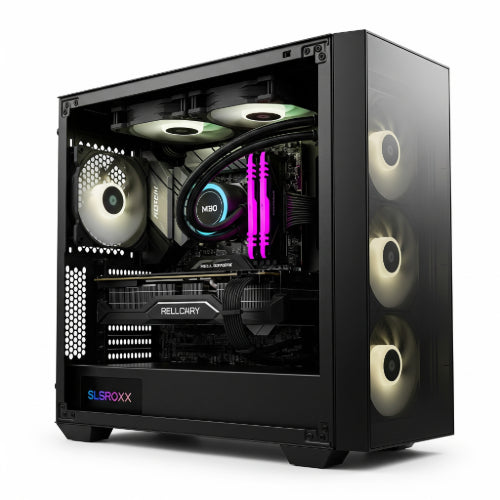Level Up Your Game: A Step-by-Step Guide to Building Your Dream Gaming PC
Tired of laggy frame rates and potato-quality graphics? Dreaming of a rig that can handle the latest AAA titles at max settings? Building your own gaming PC might seem daunting, but it's a rewarding journey that gives you complete control over performance, aesthetics, and budget. And guess what? Even here in General Trias, Calabarzon, you can source the right components to create your ultimate gaming machine.
This step-by-step guide will walk you through the process of selecting the perfect parts for your dream gaming PC. Let's get started!
Step 1: Define Your Budget and Goals
Before diving into specific components, figure out how much you're willing to spend and what kind of gaming experience you're aiming for.
- Budget: Set a realistic budget. This will heavily influence your component choices. Remember to factor in peripherals like a monitor, keyboard, and mouse if needed.
- Gaming Goals: What games do you want to play, and at what settings (resolution, frame rate)? Are you aiming for competitive esports titles or immersive single-player experiences? This will determine the power of your CPU and GPU.
- Future-Proofing: How long do you want your PC to remain high-end? Consider spending a bit more on key components if you plan to keep the system for several years.
Step 2: Choosing the Core Components
This is where the real fun begins!
-
Central Processing Unit (CPU): The brain of your PC. For gaming, focus on clock speed and the number of cores. Intel's Core i5 and i7 series, and AMD's Ryzen 5 and Ryzen 7 series are popular choices for gaming. Consider your budget and the games you play – some games benefit more from single-core performance, while others leverage multiple cores.
-
Motherboard: The backbone that connects all your components. Choose a motherboard that is compatible with your CPU socket (e.g., LGA 1700 for Intel, AM5 for AMD) and has the features you need (number of RAM slots, PCIe slots for your GPU and SSDs, USB ports). Consider the form factor (ATX, Micro-ATX, Mini-ITX) based on your case size.
-
Graphics Processing Unit (GPU): The most crucial component for gaming. The GPU handles rendering visuals. NVIDIA's GeForce RTX series and AMD's Radeon RX series are the main contenders. Your budget and target resolution (1080p, 1440p, 4K) will dictate your choice. Check benchmarks for the games you want to play to make an informed decision.
-
Random Access Memory (RAM): Essential for multitasking and smooth gameplay. 16GB is generally the sweet spot for modern gaming, but 32GB can be beneficial for demanding titles or if you plan on streaming or running other applications in the background. Check your motherboard's specifications for compatible RAM speed (MHz) and type (DDR4 or DDR5).
-
Storage (SSD & HDD):
- Solid State Drive (SSD): Crucial for fast boot times, quick loading of games and applications, and overall system responsiveness. A 500GB or 1TB NVMe SSD is highly recommended for your operating system and frequently played games.
- Hard Disk Drive (HDD): For mass storage of less frequently accessed games, media files, and backups. A 2TB or larger HDD offers ample space at a lower cost per gigabyte than an SSD.
-
Power Supply Unit (PSU): Provides power to all your components. Choose a PSU with enough wattage to handle your system's demands, with some headroom for future upgrades. Use an online PSU calculator to estimate your power needs and opt for a reputable brand with good reviews and efficiency ratings (80+ Bronze or higher).
-
Case: The enclosure for your components. Choose a case with good airflow to keep your system cool, sufficient space for your chosen components, and aesthetics you like. Consider features like cable management options and dust filters.
-
CPU Cooler: Keeps your CPU from overheating. Stock coolers that come with some CPUs are often adequate for basic use, but a dedicated aftermarket cooler (air or liquid) can provide better cooling performance, especially if you plan to overclock your CPU.
Step 3: Sourcing Your Components in General Trias and Beyond
Finding the right components in General Trias might require a bit of resourcefulness. Here are some avenues to explore:
- Local Computer Stores: Check out computer shops in General Trias and nearby areas like Dasmariñas, Imus, and even Bacoor. While their selection might be limited, you might find some essential components or get valuable advice.
- Online Retailers (Philippines): Major online platforms like Lazada and Shopee have numerous sellers offering PC components. This often provides the widest selection and competitive pricing. Be sure to check seller ratings and reviews before purchasing.
- Physical Stores in Metro Manila: A short trip to computer hubs in Manila (like Gilmore or SM Cyberzone locations) can offer a vast array of components and competitive prices. Plan your trip accordingly.
- Social Media Groups and Forums (Philippines PC Building Community): Connect with local PC building enthusiasts online. They can provide recommendations on where to buy components and offer valuable building tips.
Pro Tip: Compare prices from different sources before making a purchase to get the best deals. Factor in shipping costs if buying online.
Step 4: Building Your PC (Step-by-Step)**
This is where patience and careful attention to detail are crucial. There are countless online tutorials and guides to help you through this process. Here's a general overview:
- Prepare Your Workspace: A clean, well-lit area with ample space is essential. Ground yourself to prevent electrostatic discharge (ESD) that can damage components.
- Install the CPU on the Motherboard: Carefully follow the CPU and motherboard manuals.
- Install RAM Modules: Align the notches and push down gently until they click into place.
- Mount the Motherboard in the Case: Secure it with standoffs and screws.
- Install the GPU: Slot it into the primary PCIe x16 slot.
- Install Storage Devices (SSDs and HDDs): Connect them to the appropriate SATA or NVMe slots on the motherboard and secure them in their bays.
- Connect the PSU: Place it in the case and connect the necessary power cables to the motherboard, GPU, and storage devices.
- Install the CPU Cooler: Follow the cooler's instructions for mounting.
- Cable Management: Neatly organize and tie down cables to improve airflow and aesthetics.
- First Boot and BIOS Setup: Connect your monitor, keyboard, and mouse and power on the PC. Enter the BIOS/UEFI settings to configure boot order and check if all components are recognized.
- Install Operating System and Drivers: Install your preferred operating system (Windows, Linux) and then install the latest drivers for all your components (especially the GPU).
Step 5: Testing and Enjoying Your Dream Rig
Once everything is installed, it's time to put your new gaming PC through its paces!
- Run Benchmarks: Use benchmarking software to test your system's performance and ensure it meets your expectations.
- Play Your Favorite Games: Enjoy the smooth frame rates and high settings you've been dreaming of!
- Monitor Temperatures: Keep an eye on your CPU and GPU temperatures, especially during intense gaming sessions.
Building your dream gaming PC is a fantastic experience. By carefully planning your components and leveraging the available resources in General Trias and the wider Philippines, you can create a powerful rig that will provide countless hours of gaming enjoyment. Happy building, and see you in the virtual battlefield!







